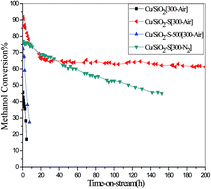A novel supported Cu catalyst with highly dispersed copper nanoparticles and its remarkable catalytic performance in methanol decomposition†
Abstract
Using starch modified SiO2 as the support, an efficient copper catalyst with superior catalytic performance for methanol decomposition can be obtained, suggesting the key role of the nature of the support in preparing Cu/SiO2 catalysts with stable and highly dispersed copper nanoparticles using an impregnation method.


 Please wait while we load your content...
Please wait while we load your content...